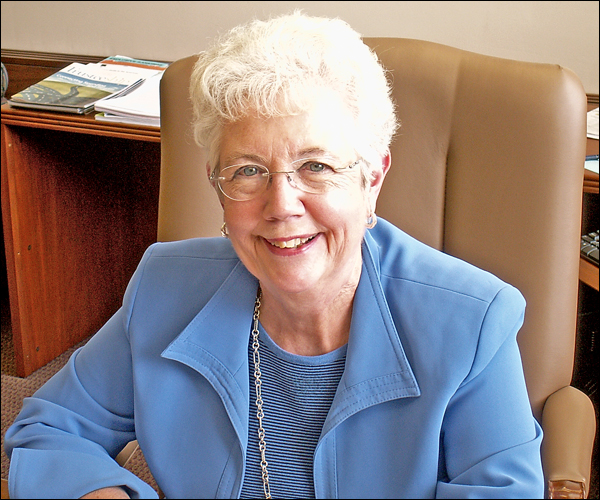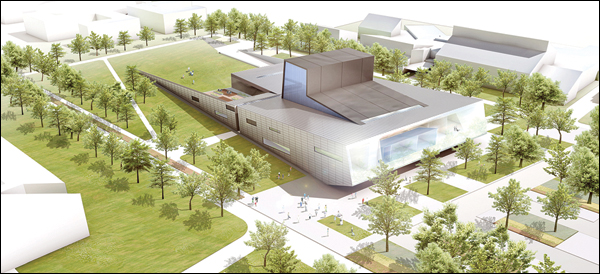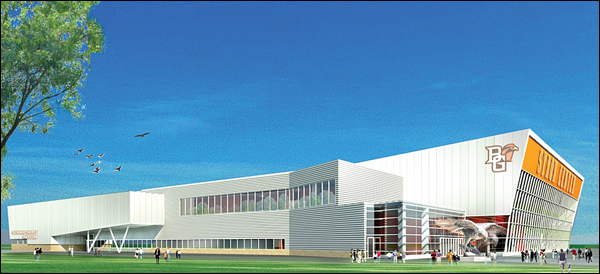
As published in the September 1, 2009 Toledo Business Journal

Dr. Carol A. Cartwright,
Bowling Green State University
Toledo Business Journal recently interviewed Dr. Carol A. Cartwright, president, Bowling Green State University (BGSU). She shared the following thoughts.
Toledo Business Journal: Can you discuss the role that BGSU plays in regional economic development?
Carol Cartwright: We believe that we have a major role to play in regional economic development and even beyond the region into the state and the nation.
One of the best ways we deliver on that commitment is through baccalaureate level education. It is a fact that places with a higher percentage of baccalaureate-prepared citizens are doing better economically. Regardless of field of study, baccalaureate degree production is very important to economic development.
Of course, there are areas that might seem more obvious, such as our commercialization of research. New ideas can lead to new products and new businesses. The contributions we make to quality of life also have a very important attraction function in terms of new businesses locating in our region or retaining business in the area. People care about the quality of K-12 education, health and wellness opportunities, and recreation opportunities, and we have programs that contribute in all of those areas.
We take a very comprehensive view about contributing to regional economic development.
TBJ: Can you discuss the issue of collaboration among area universities and colleges?
CC: That’s a very interesting question, because many people talk about collaboration as being valuable, and not as many talk about the very hard work it takes to actually make partnerships work. We’re working hard to make them effective.
The five area presidents – from Northwest State Community College, Terra State Community College, Owens Community College, the University of Toledo (UT), and BGSU – meet monthly to talk about what’s on their minds. We don’t have a formal agenda, but it’s an opportunity to keep connected, keep talking, and keep sparking new ideas. Often, those ideas lead to new collaborations.
Nobody really can be completely in charge of anything anymore. The problems are too multi- faceted, and the issues are too complex. It takes a good team of people working together – and many collaborations – to solve today’s problems.
I go back to an understanding of faculty. Faculty members are natural collaborators. They’re interested in problems, and they reach out all over the world to find people who have the same interests, and they begin building networks.
So, we have a university-wide encouragement to get engaged. We create environments so that faculty reach out the way they are naturally inclined to do.
We believe very strongly in collaborations, and we’re pleased that it’s in the DNA of our organization.
There are hundreds of collaborations that are already in place in the region. I think that people would be astonished to see how robust the collaborations are, because they like to have some fun with the competitive environment between institutions. Yes, on the basketball court or the football field, we do go at each other head to head. But, at the heart of our mission we’re focused on the same goals for the state of Ohio, and we understand that we complement each other in many ways and that we want to be leveraging those complementarities for the good of the region and the state.
TBJ: Can you share specific examples of collaboration efforts among area universities and colleges?
CC: We are the sponsor of the Toledo School for the Arts. That’s a great partnership between our faculty in education and the arts and a public school that’s creating a very interesting educational opportunity for young people. We’re very proud of the success we’re having there. It’s a traditional education in terms of the learning outcomes that are expected of students, but they come at it in a rather non-traditional way, and they do it with the guidance of our faculty.
There’s a big economic engine underneath all of this. Mike Carroll, who runs our Center for Regional Development (CRD), completed a regional study and then a statewide study on the economic contribution of what are called the creative industries. The impact for northwest Ohio is $2.3 billion annually. So, the Toledo School for the Arts students are being guided toward careers that have very significant long-term economic potential for our area.
Carroll’s statewide study was rolled out in April at the Ohio Arts Council event in Columbus.
We also have a very interesting partnership with the Community College of the Air Force, which allows individuals who are completing an associate degree with the Air Force program to enroll in our online baccalaureate degrees. We have the potential to serve people all over the world through this partnership.
It also extends to their spouses and immediate dependents as well. So, the reach there is very significant.
We have many partnerships in the area of alternative energy. In the field of photovoltaics, we have basic scientists in the photochemical sciences department who are working on the next generation of solar. They work in partnership with the engineers at the University of Toledo as projects begin to mature to the point where they’re ready for commercialization.
BGSU has the only PhD program in photochemical sciences in the world. We attract students from all over the world.
In the alternative energy field, we also have a number of projects in wind energy. Often, the engineering expertise comes from UT. Expertise in other science fields comes from Bowling Green. There are a number of those projects funded by Federal as well as State grants, including the Wright Center for Photochemical Sciences.
We also work in health and human service areas with UT. For example, we share a nursing program. Students go attend BGSU but they do their nursing courses at UT, and they earn a joint degree from BGSU and UT. There are a number of other areas where their expertise in clinical medicine can be leveraged with our commitment to health and wellness across the lifespan.
We focus on the promotion and wellness side, and they focus on the clinical side. Together, we provide a great deal of expertise for the region in the areas of health and wellness.
A number of projects are in STEM areas: science, technology, engineering, and math. Some would add medicine. We probably have the largest number of partnerships in the state to encourage young people to get into STEM fields.
There are a number of programs to leverage scholarship dollars between Owens and Bowling Green, focused on STEM education.
There are also internal collaborations that are very important. For example, the Dallas-Hamilton Center for Entrepreneurial Leadership in the College of Business worked with Bob Vincent, faculty member in Geology, to help bring an idea into the market and create a new business called Blue Water Satellite, Inc. They map water supplies to conduct early spotting of algae blooms and other problems in water quality. It was that partnership between the professor and the Dallas-Hamilton Center for Entrepreneurial Leadership that resulted in the opportunity to spin off a new company.
TBJ: State of Ohio funding to higher education has been significantly strained. Can you discuss the impact of reductions in State of Ohio funding on BGSU?
CC: We’ve been following the likely scenarios in State funding very carefully because of the challenge nationally and the impact for the State’s economy. We have also been planning accordingly so we don’t have a crisis. Of course we have fewer resources to work with, and we’ve had to bring our expenses in line with that reality.
But, as I said, we’ve been planning so that we don’t have to deal with something that’s bad news on an abrupt or crisis basis. We have been predicting what’s going to happen and gradually adjusting our expense basis in line with our revenues.
The most obvious immediate changes for us are that the line items in the State budget were cut. Areas that have been important for BGSU and for the regional economy, like the Canadian Studies Center, were a separate line item in the budget and they were zeroed out. Now we’re looking for ways to continue some of those activities. But, every school had to deal with the loss of line items.
All of higher education lost basic instruction-based State support, and we also lost student financial aid. Because of this loss, the opportunities are there for us to consider raising tuition. We have decided at this point not to do that for fall. But, we may do it for the spring semester. That’s still under consideration.
In effect, some burden was shifted back to students and families right at the end of the budget making process when the State’s deficit was just too big to manage any other way. We have been working very closely with the Chancellor of the Ohio Board of Regents and the Governor to maintain the strength in higher education, because everyone understands that higher education and what we can contribute is the way out of the current economic problem. That’s why the Governor and the Chancellor worked so hard right to the very end to maintain the State’s support. However, that wasn’t possible, because the deficit was just too big.
Yes, we’ve closed or scaled back some programs. We’ve dramatically changed the way we do our work. We’ve stepped up all the things we know how to do to be more efficient in purchasing goods and services, and we’ve scaled people back from 12 month to nine or ten month contracts. These are all things that we did as prudent managers, because we knew that we had to bring our expenses in line with our revenue.
No institution can stand up and say there have been no implications and that they haven’t had to deal with cutting expenses. But I think we’ve done it in a very planned way where we’ve been very transparent and very open with our community about what we’re dealing with and how we’re going to deal with it, with the goal of trying to protect the core mission to the greatest extent possible.


(top) Wolfe Center for the Arts rendering; (bottom) Stroh Center rendering
TBJ: Can you discuss plans for investment in new facilities at BGSU?
CC: We’re very excited about some new opportunities. We will very soon see the construction cranes and the shovels in the ground for two very important new buildings: the Stroh Center, which will be a new convocation center, and The Wolfe Center for the Arts.
We’ve already had the groundbreaking for the Wolfe Center and the Stroh Center groundbreaking will be on September 3. These are both long awaited facilities, and each is about $38 million in scope.
The Wolfe Center is an opportunity for the kind of internal collaboration that I talked about earlier. It will be placed between the School of Art and the College of Musical Arts, and it has been designed to draw people back and forth and inside and to become involved in collaborations. It will be the new home of theater and film; their offices and programs will relocate there. But, the majority of the building is space for students and faculty to work together across all of the arts. We’re really creating a kind of arts neighborhood there that’s going to be very exciting.
Stroh enables us to have an updated facility, not just for basketball and volleyball, but also for major university events like commencement and concerts.
Generally speaking, the buildings will be ready for fall 2011. The Stroh project is already bid, and the Wolfe Center is in the bid process right now.
Very soon, we will take a master plan for renovating our residence halls and dining facilities to our board of trustees. That will be a very ambitious project, and we will expect to have new rooms and new dining facilities on line for fall 2011. So, we’ll have a very ambitious timetable there as well.
We believe that the residence halls are not just places to put your head at night. They are important out of class learning opportunities. We have many learning communities and student success centers in our halls. We see them as living / learning facilities; the renovations will be designed with that philosophy in mind and anything new that we build will keep that in mind as well.
We have also already completed the engineering work to look at the structural integrity of our original buildings – University, Hanna, and Moseley Halls. They will be next in the queue for the State capital funding for academic buildings.
TBJ: Do you see opportunities for area businesses to work more closely with BGSU?
CC: Absolutely. We are an institution that is committed to being engaged with the community, and we are always eager to explore new opportunities. There are literally thousands of things that go on during the course of the year where there are connections between the community, businesses, and the university. Many of them center on the college of business, and the Dallas- Hamilton Center for Entrepreneurial Leadership is there to encourage businesses to come and seek advice about their own entrepreneurial activities. These programs draw people in to gain expertise.
We are constantly looking for more opportunities for our students to be involved in co-ops, internships, and other ways they can translate their education into real world experiences. And we’re constantly scanning the environment and building our network so we can expand the opportunities for those partnerships.
TBJ: Are there any other issues that you would like to address?
CC: Two issues are really threaded through what I’ve already told you. First is our new strategic plan. One of the seven priorities involves reimagining the entire undergraduate experience so that we can assure that out of class activities are carefully integrated with in class activities to make for a better holistic experience as an undergraduate.
There are a number of high impact practices that are well documented in higher education to lead to better retention and better graduation. For example, honors programs, study abroad, learning communities, internships and co-ops, academic clubs, and organizations allow students to engage in their area of interest.
We have all of those in place at BGSU, but they’re generally not required as a part of studying in a particular field. So, we have a major project under way to implement that strategic priority. It’s called CUE (Connecting the Undergraduate Experience), where we will very deliberately map out of class experiences that would be particularly important to pursue if you are in certain academic areas. We want students to have these opportunities to translate their learning into other opportunities.
CUE will be a university-wide transforming initiative, and it comes out of a strategic plan that was built from the ground up. The plan was built with a process that was very grassroots oriented, which tells you that the people here already own the idea. We’re just going to make sure that we have all the pieces formalized so we can promise every student that kind of experience. It will be a small school experience in a big school environment – the best of both worlds.
Second, we have submitted our five centers of excellence to the Chancellor and the Ohio Board of Regents. These centers were developed through a very rigorous internal review process, and we insisted that any proposal be multi-disciplinary, because we believe that today’s problems cross fields of study and that they clearly show a contribution to economic development.
In the end, we have five centers that were approved by our board – health and wellness across the lifespan, educator preparation for the 21st century, alternative energy and sustainability, the arts, and high performing organizations.
We’ve been disciplined about only selecting areas to call centers of excellence that meet our rigorous internal criteria. We had 13 proposals and accepted five.
Finally, we own a library repository at Levis Commons. It is a wonderful opportunity for us to rethink what we do with some of the common spaces in that building. We are renovating some office space to be classroom space. Beginning in the fall, we will offer our professional MBA programs there at Levis Commons, and we are also going to be housing more of our continuing education staff there, focusing on programs for adult learners. It will be ready for classes this fall.